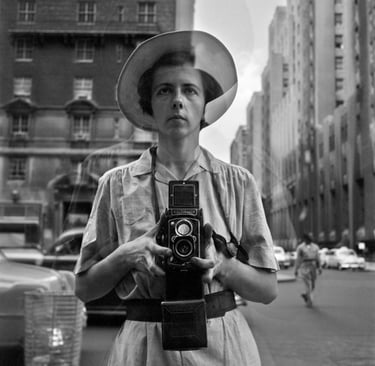Photography in Reverse: The TLR and 5x4 Street Photography Experience
How Candid Photography Survived Upside Down and Backwards
Ah, street photography—the art of capturing candid moments, unfiltered and unposed, in all their urban glory. It’s a genre that thrives on quick reactions and stealth. But let me tell you, back in the day, shooting street photos wasn’t quite the simple “point and shoot” affair we’re used to now. In fact, if you were using a TLR (twin-lens reflex) or a 5x4 large format camera, you had to deal with a world flipped backwards, sometimes even upside down. Yet, some of the most legendary street photographers thrived with these quirky machines, capturing life as it unfolded.


The TLR: The Original Sneak Attack Camera
Before digital screens gave us the luxury of seeing exactly what we were shooting, TLRs were the camera of choice for many early street photographers. My first TLR was a Yashica 635, but perhaps the most famous user of this type of camera was none other than the elusive and now legendary Vivian Maier. She stalked the streets with her trusty Rolleiflex, snapping candid shots of everyday life without drawing attention to herself. The magic of the TLR lay in the fact that you looked down into the viewfinder, meaning you didn’t have to raise the camera to your eye and startle your subject. It was the original "sneak attack" camera for street shooters—perfect for capturing unguarded moments.
Of course, there was a catch. Everything you saw in that waist-level viewfinder was reversed left to right. So, when you tried to move the camera left, the image would shift right. Confusing? Oh, you bet. It was like trying to brush your teeth while looking in a mirror—simple in theory, yet totally baffling in practice. And if you wanted a high-angle shot, say over a crowd, you had to hold the TLR above your head, trying to frame the shot while staring at an upside-down world in a shaky viewfinder. I wouldn’t recommend it unless you enjoy guessing games.
Parallax Problems: The Close-Up Conundrum
Ah, but the TLR wasn’t done with its tricks. There was also the dreaded parallax issue. You see, the TLR had two lenses—one for the viewfinder and one for the actual shot. When shooting close-ups, what you saw through the viewfinder didn’t exactly match what the camera was actually going to capture. The difference could be enough to throw off your framing entirely, leading to some hilarious (and frustrating) surprises when you developed the film. It's a wonder we ever managed to nail those shots.
5x4 Large Format: The Puzzle Camera for the Patient Photographer
Now, as challenging as the TLR was, it was nothing compared to the 5x4 large format camera, like my MPP Micropress. These were the big guns—the cameras that press photographers used when they needed ultimate clarity and detail. But of course, there was a catch. Or two. Or ten.
First, the image on the ground glass of a 5x4 camera was not only reversed but also upside down. Yes, you read that right. Imagine trying to frame a street scene when every part of the world is flipped in both directions. Left was right, right was left, up was down… you get the picture (sort of). The greats who used these cameras, like press photographers in the early 20th century, didn’t have the luxury of what you see is what you get. Instead, they had to mentally flip the scene back into position before clicking the shutter.
And if you think framing was hard, try focusing. With a 5x4, you didn’t have a handy autofocus button. Instead, you had to tilt and shift the lens to correct perspective or achieve sharp focus. And this was done while staring at an upside-down, reversed version of reality. Oh, and let’s not forget the process of loading the film holder, pulling the dark slide, and finally pressing the shutter after what felt like hours of setup. If the moment you were trying to capture hadn’t passed by then, you were lucky!
The Street Legends Who Made It Work
Despite these challenges, there were photographers who thrived with these tools. Aside from Maier with her Rolleiflex, street and candid photographers like Robert Doisneau and Brassaï made their mark using cameras like the Rolleiflex and the Graflex Speed Graphic (for the large format enthusiasts). While we often associate street photography with 35mm cameras, these bulkier formats allowed photographers to take candid, raw shots before the genre even had a name.
Even Weegee, known for his sensational press photos in New York, used a Graflex Speed Graphic with a sports viewfinder—essentially a wire frame with no optics—to quickly frame his shots. Talk about trusting your instincts!
Modern Day: How Easy We Have It
Fast forward to today, where every digital camera, phone, and even smartwatch shows you exactly what you're going to get before you take the shot. We take it for granted now. No more reversed images. No more parallax problems. No more upside-down realities. We just point, shoot, and—like magic—the image appears, perfect and ready for Instagram.
It’s easy to forget that street photographers in the past were working with tools that actively fought against them. But they did it anyway, capturing the raw, unfiltered moments of urban life. Today, we might marvel at their work, but we often forget just how much of it was achieved through sheer determination, patience, and an ability to work with cameras that seemed hell-bent on creating confusion.
A Final Thought: The Trade-off
So here’s to the TLR and the 5x4—cameras that flipped the world upside down and backwards, yet allowed photographers to capture it with clarity and precision. They may have been tricky to use, but they taught us patience and attention to detail. And if nothing else, they remind us of how easy we have it today.
Next time you effortlessly line up a shot on your digital camera, spare a thought for the photographers of the past. They didn’t have live view or autofocus, but they made it work. And in doing so, they helped shape street photography into the art form we know today.
Copyright © 2025 Peter Pickering. All Rights Reserved. All Wrongs Reversed.
🌐 peterpickering.com | 🎺 sessionsonthegreen.com | 💜 isaacbcole.com | ▶️ YouTube Channel | 🌿 life.peterpickering.com


